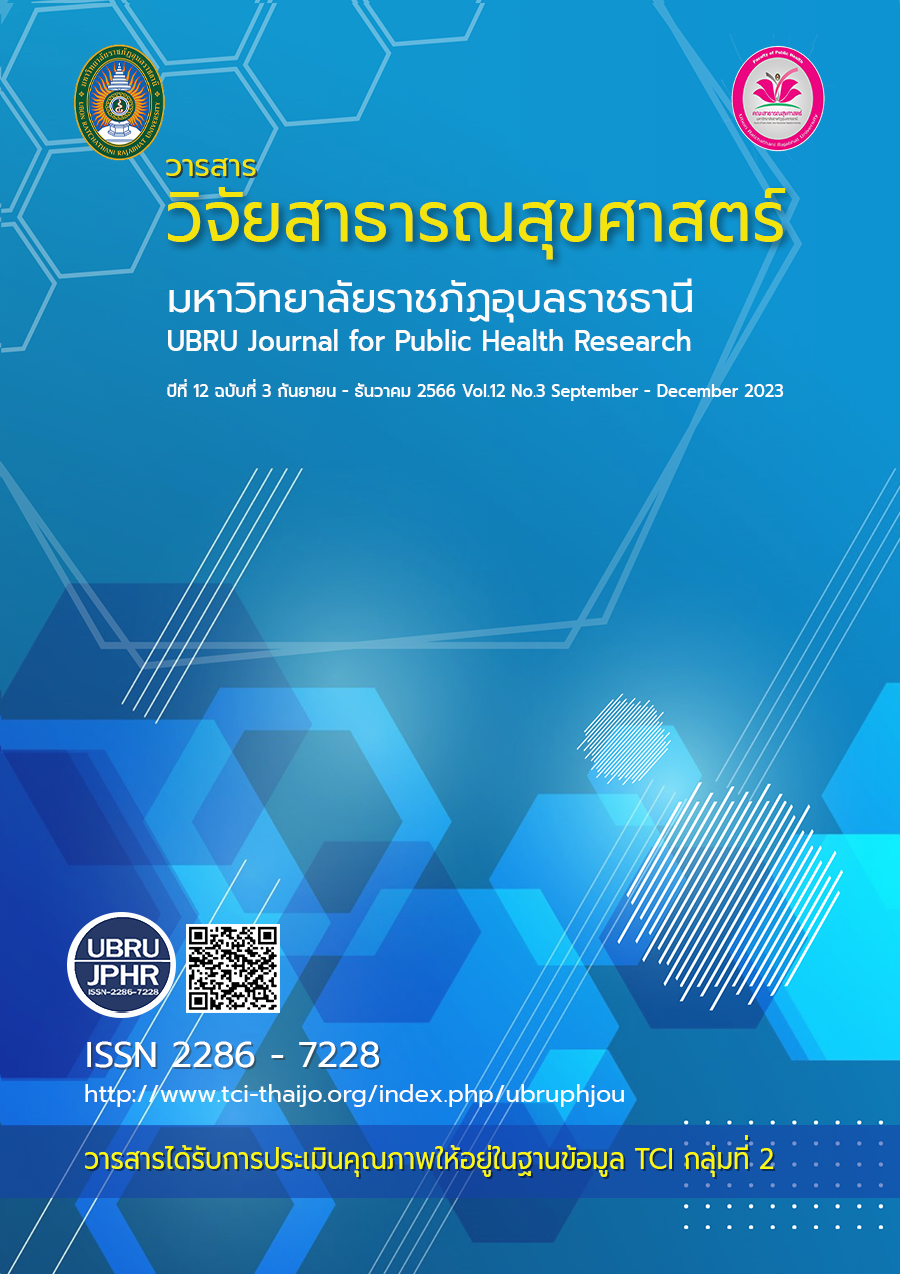ความรู้และพฤติกรรมการป้องกันโรคโควิด 19 ของนักศึกษาระดับปริญญาตรี คณะศิลปศาสตร์และวิทยาศาสตร์ มหาวิทยาลัยราชภัฏศรีสะเกษ
คำสำคัญ:
โควิด 19, ความรู้, พฤติกรรมการป้องกันโรคโควิด 19บทคัดย่อ
สถานการณ์การแพร่ระบาดของโรคโควิด 19 ส่งผลต่อสุขภาพและการดำรงชีวิตประจำวันของนักศึกษาเป็นวงกว้าง การศึกษาครั้งนี้เป็นการศึกษาภาคตัดขวางเชิงสำรวจ ( Cross sectional Survey Study ) มีวัตถุประสงค์เพื่อศึกษาความสัมพันธ์ระหว่างความรู้เกี่ยวกับโรคและการป้องกันโรคโควิด 19 กับพฤติกรรมการป้องกันโรคโควิด 19 ของนักศึกษาระดับปริญญาตรี คณะศิลปศาสตร์และวิทยาศาสตร์ มหาวิทยาลัยราชภัฏศรีสะเกษ กลุ่มตัวอย่างเป็นนักศึกษาระดับปริญญาตรี ภาคปกติ ชั้นปีที่ 1-4 จำนวน 124 คน คัดเลือกกลุ่มตัวอย่างโดยใช้วิธีสุ่มอย่างง่าย เครื่องมือที่ใช้ในการศึกษาได้แก่ แบบสอบถามเกี่ยวกับปัจจัยส่วนบุคคล ความรู้เกี่ยวกับโรคและการป้องกันโรคโควิด 19 และพฤติกรรมการป้องกันโรคโควิด 19 วิเคราะห์ข้อมูลโดยใช้สถิติเชิงพรรณนา และสัมประสิทธิ์สหสัมพันธ์ของ
เพียร์สัน
ผลการศึกษาพบว่าภาพรวมนักศึกษามีความรู้เกี่ยวกับโรคและการป้องกันโรคโควิด 19 ในระดับปานกลาง (Mean=6.65, SD=1.43) โดยข้อที่ตอบถูกมากที่สุด 3 ลำดับแรก คือ การป้องกันโรคโควิด 19 อาการบ่งชี้ และอาการเบื้องต้นเมื่อได้รับเชื้อโรค
โควิด 19 (ร้อยละ 97.58, 96.77 และ 92.74) ข้อที่นักศึกษาตอบถูกน้อยที่สุด 3 ลำดับแรกคือ ความหมายของโรคโควิด 19 การปฏิบัติตนเมื่อเป็นบุคคลที่มีความเสี่ยงสูง และความแตกต่างของอาการติดเชื้อโรคโควิด 19 กับเชื้อไข้หวัด (ร้อยละ 33.06, 62.90 และ 66.13) พฤติกรรมการป้องกันโรคโควิด 19 ในภาพรวมอยู่ในระดับดีมาก (Mean=4.36, SD=0.82) โดยข้อที่มีค่าเฉลี่ยสูงสุด
3 ลำดับแรก คือ นักศึกษาเปลี่ยนหน้ากากอนามัยเป็นประจำทุกวัน (Mean=4.57, SD=0.70) รองลงมาคือ นักศึกษาสวมหน้ากากอนามัยตลอดเวลาเมื่อพบปะบุคคลอื่น (Mean=4.56, SD=0.72) และนักศึกษาตรวจวัดอุณหภูมิทุกครั้งก่อนเข้าสถานที่สาธารณะ (Mean=4.55, SD=0.68) ข้อที่มีค่าเฉลี่ยน้อยที่สุด 3 ลำดับแรก คือนักศึกษาสแกนไทยชนะทุกครั้ง ก่อนเข้า-ออกสถานที่สาธารณะ (Mean=4.10, SD=1.11)นักศึกษาเข้ารับการตรวจ ATK ฟรีที่สถานให้บริการใกล้บ้านตลอด เมื่อพบว่าตนเองมีความเสี่ยงที่จะ
ติดโรคโควิด 19 (Mean=4.13, SD=0.99) และเมื่อสงสัยว่าติดโรคโควิด 19 นักศึกษาสามารถเข้ารับการตรวจ ATK ในสถานบริการใกล้บ้านหรือสามารถตรวจได้ด้วยตนเอง (Mean=4.26, SD=0.84) ความรู้เกี่ยวกับโรคและการป้องกันโรคโควิด 19 มีความสัมพันธ์ทางบวกระดับปานกลางกับพฤติกรรมการป้องกันโรคโควิด 19 อย่างมีนัยสำคัญทางสถิติ (r=.58, p<.01)
สรุปจากผลการศึกษาสามารถนำมาเป็นแนวทางในการกำหนดกิจกรรมการเรียนการสอนโดยเพิ่มเนื้อหาความรู้เกี่ยวกับการป้องกันโรคโควิด 19 จัดโครงการอบรมให้ความรู้เกี่ยวกับโรคและการป้องกันโรคโควิด 19 ให้กับนักศึกษาคณะศิลปศาสตร์และวิทยาศาสตร์ ให้มีพฤติกรรมการป้องกันโรคที่ถูกต้องเหมาะสม เพื่อให้สามารถป้องกันและควบคุมการแพร่ระบาดของโรคโควิด 19
เอกสารอ้างอิง
กรมควบคุมโรค. (2564). กรมควบคุมโรค แนะประชาชนที่กำลังทยอยเดินทางกลับหลังปีใหม่ ยึดหลัก D-M-H-T-T เพื่อป้องกันตนเองจากโรคโควิด 19. ค้นเมื่อ 29 ธันวาคม 2564, จาก https://ddc.moph.go.th/brc/news.php?news=16434&deptcode
ณัฐริกา พร้อมพูน และคณะ.(2565). ความรอบรู้ทางสุขภาพด้านการป้องกันโรคโควิด-19 และพฤติกรรมสุขภาพแบบชีวิตวิถีใหม่ของนักศึกษาพยาบาล คณะพยาบาลศาสตร์ มหาวิทยาลัยอุบลราชธานี.[ฉบับอิเล็กทรอนิกส์].วารสารสุขภาพและการพยาบาล มหาวิทยาลัยอุบลราชธานี, 1(1), 16-27.
ธัชธา ทวยจัด และคณะ. (2565). ความรู้ เจตคติและพฤติกรรมการป้องกันและควบคุมโรคโควิด 19 ของอาสาสมัครสาธารณสุขประจำหมู่บ้าน จังหวัดจันทบุรี.[ฉบับอิเล็กทรอนิกส์].วารสารสาธารณสุขมหาวิทยาลัยบูรพา, 17(2), 42-55.
นงณภัทร รุ่งเนย, เพ็ญแข ดิษฐบรรจง, ภคพร กลิ่นหอม, ศิริพร ครุฑกาศ, และนภาภรณ์ เกตุทอง. (2563). ปัจจัยทำนายพฤติกรรมการเฝ้าระวังและป้องกันการติดเชื้อโรคโควิด 19 ของนักศึกษาพยาบาล. เพชรบุรี: วิทยาลัยพยาบาลพระจอมเกล้า.
บงกช โมระสกุล และพรศิริ พันธสี .(2564). ความรู้และพฤติกรรมการป้องกันโรคโควิด 19 ของนักศึกษาพยาบาลชั้นปีที่ 1 วิทยาลัยนานาชาติเซนต์เทเรซ่า และวิทยาลัยเซนต์หลุยส์.[ฉบับอิเล็กทรอนิกส์].วารสารศูนย์อนามัยที่ 9, 15(37), 179-195.
ประคอง กรรณสูตร. (2542). สถิติเพื่อการวิจัยทางพฤติกรรมศาสตร์. พิมพ์ครั้งที่ 3. กรุงเทพฯ : สำนักพิมพ์จุฬาลงกรณ์มหาวิทยาลัย.
พันธุ์ทิพา หอมทิพย์. (2565). โควิด 19 บนเส้นทางเปลี่ยนผ่านสู่โรคประจำถิ่น.ค้นเมื่อ 27 มิถุนายน 2566. จากhttps://www.senate.go.th/assets/portals/93/fileups/253/files/san/Covid19.pdf
มาลี เกื้อนพกุล, สุวิมล พนาวัฒนกุลและพีรยา นันทนาเนตร. (2564). ความสัมพันธ์ระหว่างความรู้ ความเชื่อด้านสุขภาพกับพฤติกรรมการป้องกันและควบคุมโรคโควิด -19 ของบุคลากร และนักศึกษาคณะพยาบาลศาสตร์ มหาวิทยาลัยเทคโนโลยีราชมงคลธัญบุรี. [ฉบับอิเล็กทรอนิกส์].วารสารพยาบาลกระทรวงสาธารณสุข, 2(31), 81-92.
สำนักงานกองทุนสนับสนุนการสร้างเสริมสุขภาพ.(2564). ยึดหลัก D-M-H-T-T ป้องกันโควิด-19. ค้นเมื่อ 3 กุมภาพันธ์ 2564, จาก https://www.thaihealth.or.th/Content/54381-M-H-T-T.html
สำนักส่งเสริมและบริการวิชาการ มหาวิทยาลัยราชภัฏศรีสะเกษ.(2564). จำนวนนักศึกษาคณะศิลปศาสตร์และวิทยาศาสตร์.ค้นเมื่อ 8 ธันวาคม2564,จาก https://docs.google.com/spreadsheets/d/1LDZKM4NSB2KQeTozMnZjeBwJVUejKqZJWA9_aFzwJks.
Best, John W. (1986). Research in Education. 5th ed. New Jersey: Prentice Hall, Inc.
Green, L. Krueter , M. (1999). Health Promotion Planning An Education Approach. 3ed Toronto: Mayfield Publishing Company.
Grimes DA, Schulz KF. Bias and causal associations in observational research. The lancet.2002;359(9302):248-52.
Wayne, W. D.(1995). Biostatistics: A foundation of analysis in the health sciences. 6thed. New York: John Wiley & Sons.
World Health Organization. (2564). คำแนะนำสำหรับประชาชนเกี่ยวกับเชื้อไวรัสโคโรนาสายพันธุ์ใหม่. ค้นเมื่อ 29 ธันวาคม 2564, จาก https://www.who.int/thailand/emergencies/novel-coronavirus-2019/advice-for-public?fbclid
World Health Organization. (2566). WHO Thailand Weekly Situation Update No. 265. ค้นเมื่อ 22 มิถุนายน 2566, จาก https://cdn.who.int/media/docs/default-source/searo/thailand/2023_06_13_tha-sitrep-265-covid-19.pdf?sfvrsn=77ab97ea_1
ดาวน์โหลด
เผยแพร่แล้ว
รูปแบบการอ้างอิง
ฉบับ
ประเภทบทความ
สัญญาอนุญาต
ลิขสิทธิ์ (c) 2023 คณะสาธารณสุขศาสตร์ มหาวิทยาลัยราชภัฏอุบลราชธานี

อนุญาตภายใต้เงื่อนไข Creative Commons Attribution-NonCommercial-NoDerivatives 4.0 International License.
เนื้อหาและข้อมูลในบทความที่ลงตีพิมพ์ในวารสารวารสารวิจัยสาธารณสุขศาสตร์ มหาวิทยาลัยราชภัฏอุบลราชธานี ถือเป็นข้อคิดเห็นและความรับผิดชอบของผู้เขียนบทความโดยตรงซึ่งกองบรรณาธิการวารสาร ไม่จำเป็นต้องเห็นด้วย หรือร่วมรับผิดชอบใดๆ
บทความ ข้อมูล เนื้อหา รูปภาพ ฯลฯ ที่ได้รับการตีพิมพ์ในวารสารนี้ ถือเป็นลิขสิทธิ์ของวารสารฯ หากบุคคลหรือหน่วยงานใดต้องการนำทั้งหมดหรือส่วนหนึ่งส่วนใดไปเผยแพร่ต่อหรือเพื่อกระทำการใดๆ จะต้องได้รับอนุญาตเป็นลายลักอักษรณ์จากบรรณาธิการวารสารนี้ก่อนเท่านั้น


